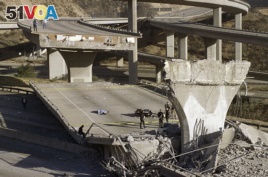10 January 2021
The Federal Emergency Management Agency, known as FEMA, is responsible for preparing the United States for natural disasters.
One way the agency works to be prepared is by trying to predict where disasters might happen in the future.
The information FEMA gathers is calculated and put into a tool called the National Risk Index.
The index takes a look at natural disasters such as earthquakes, floods, forest fires, tornadoes and more. It also takes population and building density into consideration.

FILE - In this Jan. 17, 1994, file photo, the covered body of Los Angeles Police Officer Clarence Wayne Dean lies near his motorcycle which plunged off the State Highway 14 overpass that collapsed onto Interstate 5, after the Northridge earthquake.
Out of over 3,000 counties in the U.S., Los Angeles County in southern California is the riskiest place to live. That is home to the city of Los Angeles.
The counties in the U.S. that are home to other large U.S. cities are risky, too.
New York County, home to New York City, and Miami-Dade County in Florida have large populations, lots of buildings and homes and are close to water.
Cities that are close to water are generally considered risky due to flooding.
Other U.S. cities that have a high risk index are Philadelphia, Pennsylvania; San Antonio, Texas; and St. Louis, Missouri.
There are some places in the U.S. that are at high risk for natural disasters, but they do not rank as high on this list.
For example, Oklahoma County, in the state of Oklahoma, has seen over 120 tornadoes since 1950. However, FEMA says it is not as risky for tornadoes as some of the counties close to New York City. That is because if a tornado were to hit near New York, it would cause more damage and affect more people than when they hit in Oklahoma.
Susan Cutter is the director of the Hazards and Vulnerability Research Institute at the University of South Carolina. She worked on gathering some of the data used in the FEMA study.
She explained why densely populated counties are at risk.
"A small tornado can create a large dollar loss," she said.
Mike Grimm works for FEMA. He said one reason densely populated cities rank high on this list is because many of the residents would not be prepared for a disaster if it happened. They do not think their cities are at risk.
"Just because I haven't seen it in my lifetime doesn't mean it won't happen," Grimm said.
The list has its critics.
David Ropeik wrote a book called "How Risky Is It, Really?"
Ropeik said he did not think the FEMA study calculated the risk brought on by climate change well enough. He said people do not think things that happen infrequently are risky. But when they happen, they can cause a lot of damage.
He mentioned Superstorm Sandy, which flooded much of New York City in late October 2012.
Himanshu Grover researches land use and planning at the University of Washington. He studies how communities develop and how they manage climate change.
Grover said the FEMA tool was "a good start," but he did not think it paid enough attention to the frequency of a region's storms and disasters.
FEMA's Mike Grimm said the tool should help "homeowners and renters and communities to be more resilient."
I'm Jonathan Evans.
Seth Borenstein wrote this story for the Associated Press. Dan Friedell adapted it for Learning English. Hai Do was the editor.
________________________________________________________________
Words in This Story
calculate- v. to get a general idea about the value of something
tornado- n. a violent and destructive storm in which powerful winds move around a central point
county- n. an area of a state or country that is larger than a city and has its own government to deal with local matters
hazard- n. a source of danger
vulnerability- n. the state of being open to attack, harm or damage
infrequent- adj. an act that does not happen often
We want to hear from you. Write to us in the Comments Section.